Focus: We studied seniors who want to strengthen existing connections before they graduate, and ultimately we’d like to find and promote a habit that encourages them to do so.
Team: Erfan, Helen, Millie, Safiyah, Ni
Synthesis
In exploring this topic, our behavioral study consisted of a pre-interview, a daily journaling activity, and a post-interview. Following our baseline study, we began to synthesize our data.
Techniques:
First, we wrote facts from our behavioral study on sticky notes, then used fragmenting, chunking, and mapping to organize and categorize them.
1) Fragmenting
We put our insights from each part of the study on to sticky notes. We weren’t able to glean much info from this activity (hence no pics). However, the activities below helped garner more hidden key insights.
[ image lost somewhere in cyberspace, sorry 🙁 ]
2) Chunking
Affinity Chunking – Grouping by category revealed 5 themes:
- Joy from meeting new people/existing friends
- Anxiety from meeting new people
- Barriers to making friends
- Places good and bad for making new friends
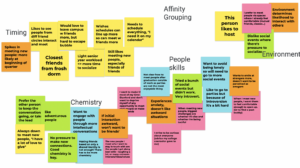
Frequency Chunking – Grouping by how often something was mentioned revealed 2 themes:
- Busy Schedules: Something that was expressed the most was a desire to meet new people/hang out with existing friends, but a lack of time to do so
- Zoom/Online Interaction: Several people expressed a dislike for Zoom when it came to meeting social interaction needs

3) Mapping
Journey Map: A more detailed journey map can be found in sections to follow, but initial synthesis included a rough Journey Map. Through this journey map, we learned that meals could serve as a good anchor for encouraging social interaction.
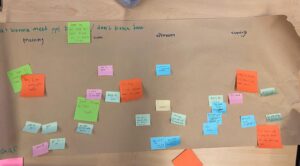
Frequency/Passion Matrix: We found out that our participants widely differed in maintaining vs making new connections, and extroversion vs introversion. Another key finding from this matrix is that social anxiety is often associated with meeting new people, but less often with maintaining existing friendships.
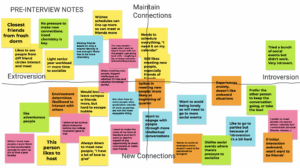
Models:
4) Connection Circle
The connection circle studies the many parts of social satisfaction. In making it, we realized that certain factors added (e.g. existing strong friendships) / subtracted (e.g. having a busy schedule) from participants’ sense of social satisfaction.
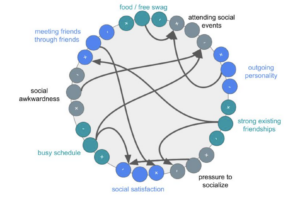
5) Fishtail Diagram
We noticed that some people left interactions deeply unsatisfied, and some felt full and happy. What goes into a socially fulfilling interaction? Through this fishbone diagram, we realized that an open schedule, available goodies (eg. free food), and familiar places and environments made social interactions fun and enjoyable.
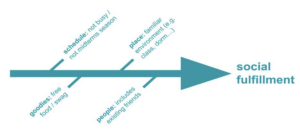
Personas
We considered a variety of factors on which to create distinct proto-personas – for instance, by how much people want to strengthen their connections, or by their level of satisfaction with their current connections. However, since we aim to solve a problem for those hoping to strengthen connections, we ended up splitting our proto-personas based on the two primary types of conflicts these seniors face in trying to strengthen existing connections before they graduate.
Persona: Somewhat Awkward Sam
| Role | Graduating senior |
| Goal | I want to meet people who I get along with… |
| Motivation | …Because I want to get to know like-minded friends to make the most of my time at Stanford. |
| Conflict | I feel anxious initiating contact and conversations with existing connections I’m not very close with. What if it starts out awkward? The uncertainty of who they are and how they think also gets to me – Is this person even interested in being friends with me? What if I spend more time with them and realize I actually don’t even want to get to know them? |
| Attempts to Solve | I try to meet friends in spaces I’m comfortable in, like major or dorm events.
I intentionally schedule 1-1 time with people, like having lunch with them. I also sometimes meet them serendipitously around campus. |
| Setting/ Environment | The kind of environment that prompts me to initiate conversations is usually serendipitous. I attend a mixer for my major or dorm, or we’re doing the same athletic activity, or I bump into them where I’m working in CoHo.
When I typically then have a conversation with them there, it’s either where I bumped into them, or for a scheduled meal in a dining hall. |
| Tools | Not much. I guess I have a phone and computer to schedule things with people and follow up, but nothing complicated |
| Skills | I’m confident in my ability to carry intellectually challenging conversations, and I enjoy asking questions to learn more about the other person. |
Persona: Time-Constrained Taylor
| Role | Graduating Student at Stanford | |
| Goal | I want to make the best use of my remaining school life, bonding with my existing friends as much as I can and expanding my network. | |
| Motivation | I feel fulfilled and happy during social interaction and want to wrap up my undergrad cheerfully. | |
| Conflict |
|
|
| Attempts to Solve | 1 – I’ve keep in touch through text and phone call
2 – I use spontaneity to meet up when possible 3 – I reserve time for friends |
|
| Setting/ Environment | I strengthen connections in private events, like eating at dining halls or going to someone’s dorm near campus. I also go to public events, like those organized by departments or residence halls. | |
| Tools | Phone call, text, social apps, computer, Google Calendar | |
| Skills | I’m comfortable with networking. When I do meet up, my conversations go smoothly. | |
| Style | Love to host parties and watch friends from different circles meet. Also love to meet friends of friends. |
Although two distinct conflicts arose – dealing with awkward interactions vs. dealing with finding time – we found these similarities.
- They both have a keen sense that undergrad is ending, and they want to make the most of the time left.
- They used similar tools to connect – calendaring apps, texting to stay in contact, and social media.
- They intentionally schedule time, like lunches, to get to know people…
- …But what they really love is spontaneous meet-ups.
Journey Maps:
Somewhat Awkward Sam:

Time-Constrained Taylor:
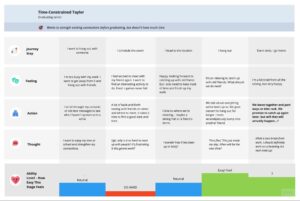
Findings of interest: As stated in our personas section, much was similar about our personas – both want to intentionally or spontaneously reconnect with people before undergrad ends. But our journey maps revealed that anxiety and difficulty levels peaked at totally different moments of a social interaction.
- Time-Constrained Taylor dreads planning the social interaction. They’re excited to meet, but more so frustrated by the back-and-forth logistics texting to actually schedule a time.
- Socially Awkward Sam suffers during the social interaction. Overwhelmed and uncertain, they have multiple thoughts at once, unable to enjoy that moment of human connection.
Intervention Ideation & Rationale:
In our product intervention brainstorming, we used our key insight from our personas: For each persona, how might we relieve the most difficult parts of strengthening connections with people? Namely, how might we reduce the anxiety of initiating contact with someone, and straighten out that jigsaw puzzle that comes with scheduling a time to meet?
After ideating and choosing three of our ideas, we chose our final intervention idea. In this process, our criteria included testability in an intervention study and strength of basis in the science of behavior change (especially nudges and anchors).
1: Send nudges at meal times to get food with friends. Allow people to indicate whether they ate alone. Send daily/weekly statistics to encourage them.
- Trigger: When people sit down anywhere to chill…
- Action: A notification is sent out letting their network know that they’re free to hang out and where
- Supporting user data:
- People want to maintain existing friendships but don’t have time, hard to get schedules to line up
- People rely on spontaneity instead
- Meal times serve as good anchors
- Pros:
- It can extend outside of mealtime and it can be used for chill activities like walking, library studying, CoHo…..
- Cons:
- We’ve used a comparative app that also pinged us whenever we “sat down to chill” (aka opened our laptop), and that gave us notification overload that made us quit the app.
- Our goal is for people to reconnect with loose connections, but people won’t want to send multiple pings about themselves to an almost-stranger every time they’re chilling and ready to meet.
- Feasibility: People’s mealtimes are different, so on the intervention administrators’ end we won’t know when to send our mealtime nudge.
2: Send nudges throughout the day, urging the participant to strike up conversations with the strangers around them at the moment
- Supporting user data: People stated that they want to meet new people but most often times they’re scared or intimidated
- Trigger: Call them at a random time in the day. If the time/space doesn’t allow for it (ie they are in the middle of class) call them at a later time.
- Action: Upon receiving the call, people must talk to a new stranger then and there. This is like BeReal, but instead of taking a picture you talk to new people
- Pros:
- It can help people who want to change for real in their skills of approaching and maintaining a conversations with strangers
- Less time investment needed to create a connection with someone. The participants can leave the interaction easily compared to when they were matched to go to dinner together which requires a bigger time investment
- Cons:
- This only solves problems for people who are time constrained – and who maybe forget to actually reach out.
- It does not help the socially awkward, since it doesn’t make reaching out any easier. Chatting with a stranger the moment your phone randomly pings you requires lots of courage.
- This idea asks people to talk to strangers – it does not help people strengthen existing connections.
- Science: Random reminders also don’t have anchors – and thus unlikely to lead to habits.
3 (the Chosen One): Ask participants to text 1 friend before bed. Participants should ask to meet and send their complete availability the next week
- Supporting user data: One group of subjects are busy and have different schedules. They want to hang out with people more often but it’s hard to spontaneously meet up with friends. The other group of subjects are socially awkward. They hope to socialize more but require a comfortable nudge.
- Trigger: Before going to bed…
- Action: …Text an acquaintance you’ve been meaning to reconnect with. Include your availability in that message.
- Pros:
- Appeals to both types of personas we explored – encourages
- In both our personas, and in our fragmenting and chunking syntheses, a lack of time was one of the most common issues found. This idea addresses that need.
- Allows for easier initiation of going to an event together as the participants will have some sort of an idea what the person is up to before even reaching out
- Cons:
- People might be reluctant to give visibility into their calendar due to privacy concerns
- We need a matching or recommendation algorithm to match up pairs of friends who have compatible schedule and interest
We chose intervention 3 because…
- This tackles both of the stresses people have with strengthening connections – it asks people to initiate contact in a low-stress setting (relaxing in the safety of your own bed, only needing to reach out to one friend).
- It makes scheduling easier by making the calendar one of the first points of the interaction. Plus, sharing the calendar is a lighthearted expression of interest to connect.
- Meanwhile, idea 1 was difficult to test (how would we know when our participant was having a meal?) and that idea 2’s lack of an anchor would not lead to habit creation.
Intervention Study
Goal: Let people efficiently initiate contact in a low-stress setting
Hypotheses our intervention addresses
- Publicizing one’s schedule among friends…
- is a time-efficient way for busy people to meet up, since it saves the effort of asking around.
- allows busy people to check out each other’s availability within seconds.
- relieves socially awkward people’s anxiety when reaching out.
- Providing a message template to reach out to people…
- relieves socially awkward people’s anxiety when reaching out.
- saves busy people’s mental load and time when reaching out
Participants
- Graduating students – eg. seniors, 2nd year Masters, PhDs in their last year…
- One student happens to come from our baseline study
- These students must want to…
- strengthen their social connections
- have people to reach out to. This can even include long-distance buddies they haven’t called in a while
- have time for the study
- willing to share their conversations with us
Protocol
Here is our study protocol, with a sampling of the primary questions we asked at each stage.
Monday:
- Conduct pre-study screener & interviews
- Do you have people you’ve wanted to strengthen connections with?
- Do you struggle to find time to meet with people you’ve wanted to strengthen connections with?
- Do you have 10 minutes every night to reach out to one person and keep us updated on your progress?
- Do you agree to share your calendar information with us?
- Participants prepare for the study
- Participants write down their complete availability that week, which they can later copy/paste and send to people (goal – make it easier to send their schedule)
- Participants write down a list of 5-10 people they’ve wanted to strengthen connections with
Tuesday-Saturday, each night
- Before bed, participants text 1-2 people, sending also their availability
- We provide a reachout template for participants can use
- We text them a reminder each night
- They to fill out the end-of-day questionnaire
- They write down who they reached out to
- They submit screenshots of the actual texts they sent out
- (optional) Any updates on how scheduling and meeting up is going

Saturday
- Conduct post-study interviews. We wanted to reduce workload during the week, so we ask a lot of why’s and reflective questions now.
- How did you choose the individual you reached out to each night?
- How was the scheduling follow up? Out of the 5 people you reached out to, what is the progress on each of them?
- Can you imagine yourself doing this regularly? How regularly?
- If you weren’t doing this intervention study, would you have reached out to these people?
- Now that you did reach out to these people, did you get any value or experiences you otherwise would not have?




Comments
Comments are closed.